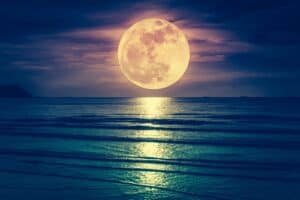The Orionid meteor shower – remnants from Halley's Comet – will be outshone by October's Full Hunter's Moon tonight.

Skygazers are in for a treat this week. Not only will October’s full Hunter’s Moon rise on Wednesday evening, it will also coincide with the Orionid meteor shower.
That said though, the meteor shower is expected to be a bit underwhelming this time around and will most likely be dulled by the full moon.
According to American Meteor Society adviser Robert Lunsford, the glow of the full moon could dull the visibility of the Orionid meteor shower by up to 75%.
Orionid meteor shower
Remnants of Halley’s Comet
The Orionid meteor shower is comprised of remnant debris left behind by Halley’s Comet (Comet 1P Halley), and radiates from the constellation Orion the Hunter, according to EarthSky.
Halley is the only known “short-period comet” which is regularly visible from Earth, and thus the only naked-eye comet that can appear twice in a human lifetime.
First predicted in 1758, the comet itself is expected to swing by our neck of the universe again on 28 July 2061.

Orionid’s peak
According to the Bronberg Weather Station in Tshwane, the meteor shower is active between 2 October and 7 November, but peaks on 20 and 21 October.
This shower in particular can produce up to 20 meteors per hour, and Orionids are known for their speed and brightness.
These small dust grains – also known as meteoroids – are distributed along the comet’s orbit, concentrated close to the nucleus with fewer grains farther away from the nucleus.
When Earth passes through this stream of debris, we experience the Orionid meteor shower, which we mistakenly refer to as “shooting stars”.
Full Hunter Moon
Why is it called the Hunter’s Moon?
The names of full moons are derived from the 1930s Maine Farmers Almanac, which uses Native American names for each month’s full moon.
The earliest use of the term, cited in the Oxford English Dictionary, is from 1710 and signalled the time to go hunting in preparation for the cold winter ahead.
While most of the full moon names are derived from both colonists and Algonquin-speaking tribes, the Hunter’s Moon is not linked directly linked to this folklore.
Instead, both September’s Harvest moon and October’s Hunter Moon are tied to the autumnal equinox in the northern hemisphere and the spring equinox in the southern hemisphere.
ALSO READ: What’s in a name? The meaning behind September’s full Harvest Moon

Other names for October’s full moon include Drying Rice Moon, Falling Leaves Moon, Freezing Moon, Ice Moon and Migrating Moon.
How to view the Orionids and full moon
Don’t get your hopes up of seeing the meteor shower tonight, but have a go at it anyway if you so wish.
Simply head out, find a dark spot and look northeast towards the constellation of Orion for the Orionids radiant. The best time to view would be between midnight and dawn.
You will have better luck at seeing the full moon, if it isn’t too cloudy.
When is the next full moon
The next full moon will appear on Saturday 20 November, also known as the Beaver Moon. This name is based on tradition and folklore as well.
According to Time&Date, Beavers typically make dams of wood and mud. They build dome-shaped homes called lodges with underwater entrances.
“Beavers continue to grow throughout their lives, and so do their teeth. They constantly gnaw on wood, but because the enamel in a beaver’s incisors contains iron, their front teeth never wear down.”






